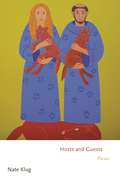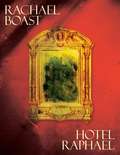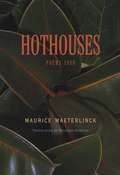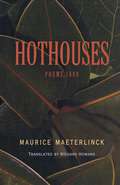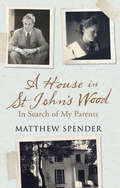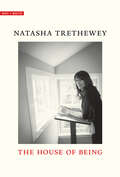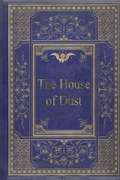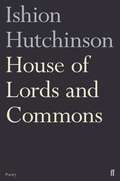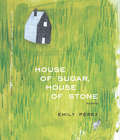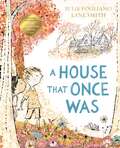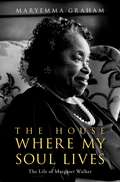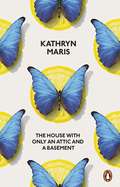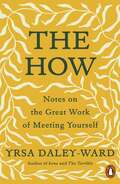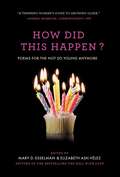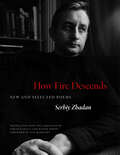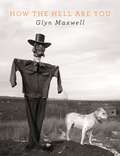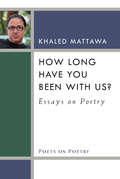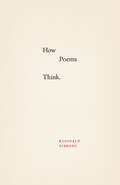- Table View
- List View
Hosts and Guests: Poems (Princeton Series of Contemporary Poets #152)
by Nate KlugAn exciting new collection from a poet whose debut was praised by Colorado Review as “a seduction by way of small astonishments”Nate Klug has been hailed by the Threepenny Review as a poet who is “an original in Eliot’s sense of the word.” In Hosts and Guests, his exciting second collection, Klug revels in slippery roles and shifting environments. The poems move from a San Francisco tech bar and a band of Pokémon Go players to the Shakers and St. Augustine, as they explore the push-pull between community and solitude, and past and present. Hosts and Guests gathers an impressive range: critiques of the “immiserated quiet” of modern life, love poems and poems of new fatherhood, and studies of a restless, nimble faith. At a time when the meanings of hospitality and estrangement have assumed a new urgency, Klug takes up these themes in chiseled, musical lines that blend close observation of the natural world, social commentary, and spiritual questioning. As Booklist has observed of his work, “The visual is rendered sonically, so perfectly one wants to involve the rest of the senses, to speak the lines, to taste the syllables.”
Hotel Raphael
by Rachael BoastHotel Raphael, Rachael Boast’s fourth collection, charts a journey through heat, drought and pain, and describes not only the reality of chronic illness, but living with it at a time of global crisis. Raphael is the patron saint of travellers and pilgrims, and also of healing; in the search for remedy, we pass through the balm of landscape, and brush against the worlds of artists, writers and filmmakers, whose angels broadcast to us from other rooms. We also encounter the biblical figure of Job, who poses the question of a terrible forbearance: how much suffering can we take, and what can we realistically change? While we fight to relieve our own pain, address the planet’s ecological imbalance and make efforts, large or small, to right its shocking injustices, we must also simply find a way through. Hotel Raphael sees Boast compose an extraordinary travelling song, one that shows us how to bear our pain without trying to erase its source.
Hothouses: Poems, 1889 (Facing Pages #2)
by Maurice MaeterlinckOn May 31, 1889, a young Belgian lawyer from a wealthy bourgeois family in Ghent published a book of 33 poems in 155 copies. Maurice Maeterlinck's legal career was floundering but his road to literary greatness had begun. Long overshadowed by the plays that later won him the Nobel Prize, Serres chaudes (Hothouses) nonetheless came to be widely regarded as one of the cornerstones of literary Modernism after Baudelaire. While Max Nordau soon seized upon Maeterlinck's--tumult of images--as symptomatic of a pervasive social malaise, decades later Antonin Artaud pronounced, "Maeterlinck was the first to introduce the multiple riches of the subconscious into literature." Richard Howard's translation of this quietly radical work is the first to be published in nearly a century, and the first to accurately convey Maeterlinck's elusive visionary force. The poems, some of them in free verse (new to Belgium at the time), combine the decadent symbolism and the language of dislocation that Maeterlinck later perfected in his dramas. Hothouses reflects the influence not only of French poets including Verlaine and Rimbaud, but also of Whitman. As for the title, the author said it was "a natural choice, Ghent . . . abounding in greenhouses." The poems, whose English translations appear opposite the French originals, are accompanied by reproductions of seven woodcuts by Georges Minne that appeared in the original volume, and by an early prose text by Maeterlinck imaginatively describing a painting by the sixteenth-century Flemish artist Pieter Brueghel. A feat of daring power extraordinarily immediate and inventive, Hothouses will appeal to all lovers of poetry, and in particular to those interested in Modernism. Maeterlinck's enormous fame may have faded, but twentieth-century writers such as Beckett are still our masters who testify to its undying influence.
Hothouses: Poems, 1889
by Maurice Maeterlinck Richard HowardOn May 31, 1889, a young Belgian lawyer from a wealthy bourgeois family in Ghent published a book of 33 poems in 155 copies. Maurice Maeterlinck's legal career was floundering but his road to literary greatness had begun. Long overshadowed by the plays that later won him the Nobel Prize, Serres chaudes (Hothouses) nonetheless came to be widely regarded as one of the cornerstones of literary Modernism after Baudelaire. While Max Nordau soon seized upon Maeterlinck's--tumult of images--as symptomatic of a pervasive social malaise, decades later Antonin Artaud pronounced, "Maeterlinck was the first to introduce the multiple riches of the subconscious into literature." Richard Howard's translation of this quietly radical work is the first to be published in nearly a century, and the first to accurately convey Maeterlinck's elusive visionary force. The poems, some of them in free verse (new to Belgium at the time), combine the decadent symbolism and the language of dislocation that Maeterlinck later perfected in his dramas. Hothouses reflects the influence not only of French poets including Verlaine and Rimbaud, but also of Whitman. As for the title, the author said it was "a natural choice, Ghent . . . abounding in greenhouses." The poems, whose English translations appear opposite the French originals, are accompanied by reproductions of seven woodcuts by Georges Minne that appeared in the original volume, and by an early prose text by Maeterlinck imaginatively describing a painting by the sixteenth-century Flemish artist Pieter Brueghel. A feat of daring power extraordinarily immediate and inventive, Hothouses will appeal to all lovers of poetry, and in particular to those interested in Modernism. Maeterlinck's enormous fame may have faded, but twentieth-century writers such as Beckett are still our masters who testify to its undying influence.
A House in St John’s Wood: In Search Of My Parents
by Matthew SpenderAn intimate portrait of Stephen Spender’s extraordinary life written by Matthew Spender, shifting between memoir and biography, with new insights drawn from personal recollections and his father’s copious unpublished archives.
The House of Being (Why I Write)
by Natasha TretheweyAn exquisite meditation on the geographies we inherit and the metaphors we inhabit, from Pulitzer Prize winner and nineteenth U.S. poet laureate Natasha Trethewey “Searching and intimate, this impresses.”—Publishers Weekly In a shotgun house in Gulfport, Mississippi, at the crossroads of Highway 49, the legendary highway of the Blues, and Jefferson Street, Natasha Trethewey learned to read and write. Before the land was a crossroads, however, it was a pasture: a farming settlement where, after the Civil War, a group of formerly enslaved women, men, and children made a new home. In this intimate and searching meditation, Trethewey revisits the geography of her childhood to trace the origins of her writing life, born of the need to create new metaphors to inhabit “so that my story would not be determined for me.” She recalls the markers of history and culture that dotted the horizons of her youth: the Confederate flags proudly flown throughout Mississippi; her gradual understanding of her own identity as the child of a Black mother and a white father; and her grandmother’s collages lining the hallway, offering glimpses of the world as it could be. With the clarity of a prophet and the grace of a poet, Trethewey offers up a vision of writing as reclamation: of our own lives and the stories of the vanished, forgotten, and erased.
House of Lords and Commons: Poems
by Ishion Hutchinson'Exquisite' (New Yorker), 'breathtaking' (Los Angeles Times), 'baroque and moon-lit' (Boston Globe) - House of Lords and Commons enthralled readers in the Americas when it recently appeared, winning the National Book Critics Circle Award in Poetry and being widely applauded in 'books of the year'. No wonder this first British publication is a significant and much anticipated event. Ishion Hutchinson's book is a profound engagement with culture and landscape, seascape and language, inheritance and race. It speaks - as its title implies - to a pursuit of justice and rebalance of a world in which lords and commoners must live side by side, and where the distance between those who 'have' and those who 'have not' is a more breaching and surprising journey than we perhaps once thought. The poems convey the complex allure of Hutchinson's native Jamaican landscape, and the violent forces that shaped its history, with remarkable lyric precision. But they speak far beyond Caribbean experience, thanks to the author's uncanny ability to reach the universal within the local. House of Lords and Commons is a skilfully crafted and tender expression of human experience in a world of prejudice and danger that is also a world of intense colour, remarkable music, indefatigable love.'Ishion Hutchinson's darkly tinged yet exuberant new poems are the strongest to come out of the Caribbean in a generation.' William Logan, New York Times Book Review
House of Sugar, House of Stone (Mountain West Poetry Series)
by Emily PérezEmily Pérez’s House of Sugar, House of Stone weaves Grimm’s Fairy Tales into the business of modern life—laptops and late nights with sleepless children—to explore an undercurrent of terror about living in a family. These poems slip between the worlds of the wolf-haunted forest and the harried house of the contemporary artist/parent, until the two blend and bleed into each other. Children learn not to trust their parents, while simultaneously yearning to win back their affections. Parents similarly question their own trustworthiness as protectors. They are devoured by children, which leaves them equally apt to dismember a lion to protect their young as they are to leave those children alone in the woods. These musical, emotionally ruthless pieces occasionally find respite, but Perez reminds us that despite our best efforts to map our way to safety: “Either way / you’re lost. Either way / you’ll wander into deeper woods.”
A House That Once Was
by Julie FoglianoIllustrated by the winner of the CILIP Kate Greenaway Medal 2017, Lane Smith, and chosen as one the New York Times Best Illustrated Books 2018.Two children come across an abandoned house deep in the woods and imagine who could have lived there. Deep in the woodsis a housejust a housethat once wasbut now isn't a home.A House That Once Was is a beautifully illustrated exploration of time, imagination and the nature of home that is sure to provoke discussion. Lane's artwork is a riot of colour and rich texture that perfectly matches the poetic text written by the New York Times-bestselling author, Julie Fogliano. This evocative, rhyming story is perfect for reading out loud.
The House Where My Soul Lives: The Life of Margaret Walker
by Maryemma GrahamThis first biography of poet and writer Margaret Walker (1915-98) offers a comprehensive close reading of a pillar in American culture for a majority of the 20th century. Without defining herself as a radical or even a feminist, Walker followed the precepts of both. She promoted the idea of the artist of tradition and social change, a public intellectual and an institution builder. Among the first to recognize the impact of black women in literature, Walker became a chief architect of what many have called the new Black South Renaissance. Her art was influenced early by Langston Hughes, her political understanding of the world by Richard Wright. Walker expanded both into a comprehensive view on art and humanism, which became a national platform for the center she founded in Mississippi that now bears her name. The House Where My Soul Lives provides a full account of Walker's life and new interpretations of her writings before and after the publication of her most well-known poem in the 1930s in Chicago. The book rejects the widely held view of Walker as the "angry black woman" and emphasizes what contemporary American culture owes to her decades of foundational work in what we know today as Black Studies, Women's Studies, and the Public Humanities. She was fierce in her claim to be "black, female and free" which gave her the authority to challenge all hierarchies, no matter at what cost. Featuring 80 archival photos and documents and based on never before examined personal papers and interviews with those who knew Walker personally, this book is required reading for all readers of biographies of American writers.
The House Where My Soul Lives: The Life of Margaret Walker
by Maryemma GrahamThis first biography of poet and writer Margaret Walker (1915-98) offers a comprehensive close reading of a pillar in American culture for a majority of the 20th century. Without defining herself as a radical or even a feminist, Walker followed the precepts of both. She promoted the idea of the artist of tradition and social change, a public intellectual and an institution builder. Among the first to recognize the impact of black women in literature, Walker became a chief architect of what many have called the new Black South Renaissance. Her art was influenced early by Langston Hughes, her political understanding of the world by Richard Wright. Walker expanded both into a comprehensive view on art and humanism, which became a national platform for the center she founded in Mississippi that now bears her name. The House Where My Soul Lives provides a full account of Walker's life and new interpretations of her writings before and after the publication of her most well-known poem in the 1930s in Chicago. The book rejects the widely held view of Walker as the "angry black woman" and emphasizes what contemporary American culture owes to her decades of foundational work in what we know today as Black Studies, Women's Studies, and the Public Humanities. She was fierce in her claim to be "black, female and free" which gave her the authority to challenge all hierarchies, no matter at what cost. Featuring 80 archival photos and documents and based on never before examined personal papers and interviews with those who knew Walker personally, this book is required reading for all readers of biographies of American writers.
The House with Only an Attic and a Basement
by Kathryn Maris'But back to the summer day the spikegrazed my brother's scalp: I slept beside himin his racing car bed and my father woke meand slapped my face, thinking, I assume, of sex,whereas I was already thinking about death.'Urban, suburban, sharply observant, now obsessive and now urbane, the poems in Kathryn Maris's third book range with a dry wit over such subjects as parenthood, marriage, adultery, the politics of children's sports contests, female prison and psychoanalysis. The House with Only an Attic and a Basement is that rare thing: a darkly funny collection of poems that courses with keen intelligence, yet wears its learning lightly so that it is a pleasure to stride along with every poem.
The How: Notes on the Great Work of Meeting Yourself
by Yrsa Daley-WardA treasure trove of inspiration and an invitation for personal renewal from the acclaimed author of bone and The TerribleWe still dream though, don't we? We are gifted with a way into ourselves, night after night after night.Yrsa Daley-Ward's words have resonated with hundreds of thousands of readers around the world: through her books of poetry and memoir bone and The Terrible, through her powerful writing for Beyoncé on Black Is King and through her always-illuminating Instagram posts.In The How, Yrsa gently takes readers by the hand, encouraging them to join her as she explores how we can remove our filters, and see and feel more of who we really are behind the preconceived notions of propriety and manners we've accumulated with age. With a mix of short, lyrical musings, immersive poetry and intriguing meditations, The How can be used to start conversations, to prompt writing, to delve deeper - whether you're on your own or with friends, on your feet or writing from the solace of home.'Lyrical . . . visceral truth is at the heart of her work' i Newspaper
How Did This Happen?: Poems for the Not So Young Anymore
by Mary D. Esselman Elizabeth Ash VelezFrom the bestselling authors of The Hell with Love, a fierce, funny, touching collection that takes the sting out of "aging while female."
How Fire Descends: New and Selected Poems (The Margellos World Republic of Letters)
by Serhiy ZhadanA searing testament to poetry’s power to define and defy injustice, from iconic writer-activist Serhiy Zhadan Since the Russian invasion of Crimea in 2014, the Ukrainian poet Serhiy Zhadan has brought international attention to his country’s struggle through his unflinching poetry of witness. In this searing testament to poetry’s power to define and defy injustice, Zhadan honors the memory of the lost and addresses the living, inviting us to consider what language can offer to a country threatened with extinction. Young lovers, marginalized outsiders, and ordinary citizens pulse with life in a composite portrait of a people newly unified by extremity. Even in the midst of enemy fire, Zhadan’s lyrical monuments beat with a subterranean thrum of hope. With a foreword by the poet Ilya Kaminsky, this selection of Zhadan’s poetry, forged entirely in wartime, is an homage to the Ukrainian people, a forceful reckoning with the violence of the past and present, and an act of artistic imagination that breaks with trauma and charts a new future for Ukraine.
How Freakin’ Zeitgeist Are You?
by Murray Lachlan YoungHow Freakin’ Zeitgeist Are You? is the definitive collection of Murray Lachlan Young’s poems from 1994 to the present day.It tracks his career as a writer and performer, from his arrival as a wide-eyed, twenty-something in London, through his sideways look in and around the music, fashion and film businesses, as well as a few observational works from what he now refers to as his ‘Cornwall years’. From his humorous and witty take on social phenomena to dark commentary on today’s society, Murray covers a wide range of topics from the weather, hair and machines to the UK festival culture, sex, men’s issues, pop music and God.The book also contains sixteen of his original illustrations and several of the sketch poems he was commissioned to write through his hugely popular slots as poet-in-residence on BBC Radio 6 Music and Radio 4’s Saturday Live.Anyone who has watched or listened to Murray perform will recognise the range of his work, from whimsical comedy and several darker pieces through satire into cosmology, theology and metaphysics. Though primarily written for the ear, with a radio listener in mind, his incurable addiction to rhyme is evident from the first page and the whole collection is designed to be read out loud and shared with friends.So open it up, find the beat and enter the strange and marvellous world of Murray Lachlan Young.
How The Hell Are You
by Glyn MaxwellA new collection from Glyn Maxwell – one of the great poetic stylists of the era, and one of its leading dramatic voices – is always a cause for celebration. Here, there are squibs and satires, lyrics and songs, poems written to family members and in memory of loved ones, a series of poems written by an artificial intelligence that will thrill and disturb in equal measure, and a chance for the blank page to finally speak for itself. But How The Hell Are You is, in its way, also a quietly political book: Maxwell regards poetry as truth-telling, and these poems – in their intimate, unsparing accounts and clear-eyed reckonings – recoil from the lies and fake news of the age to actually ‘tell it like it is’. How The Hell Are You shows a remarkable imagination and mind working at full tilt, and is the most powerful expression of Maxwell’s talent to date.
How Long Have You Been With Us?: Essays on Poetry (Poets On Poetry)
by Khaled MattawaA volume in the Poets on Poetry series, which collects critical works by contemporary poets, gathering together the articles, interviews, and book reviews by which they have articulated the poetics of a new generation. “Like the myriad companions and comrades that he summons from their exile, Khaled Mattawa is himself a ‘poet-stranger.’ In the essays, ‘written in a poet’s prose,’ collected in How Long Have You Been With Us, Mattawa evokes a powerful amalgam of the personal intimacy of the solitary and the political challenge of solidarity.” —Barbara Harlow, University of Texas at Austin “If you’ve read about exile, you’ve read about Brodsky and Milosz—just as, if you’ve read about translation, you’ve read about Walter Benjamin and George Steiner. While Khaled Mattawa has mastered these masters, his essays about world literature serve as a tour of the rest of the world. He introduces you to the writers you haven’t heard of but should from contemporary Libya and colonial South Asia to Latin America and China. When Mattawa invokes Saadi Youssef or Rabinidrath Tagore, Mohja Kahf or Toru Dutt, the effect is to deprovincialize American literature.” —Ken Chen, The Asian American Writers’ Workshop Khaled Mattawa, an American poet of Libyan origin, explores various dynamic developments shaping American poetry as it is being practiced today. Arising from an incredibly diverse range personal backgrounds, lyric traditions, and even languages, American poetry is transforming into a truly international form. Mattawa, who also translates Arabic poetry into American English and American poetry into Arabic, explores the poetics and politics of cross-cultural exchange and literary translation that fostered such transformation. The essays in this collection also shed light on Mattawa’s development as a poet and provide numerous portraits of the poets who helped shaped his poetry.
How Poems Think
by Reginald GibbonsTo write or read a poem is often to think in distinctively poetic ways—guided by metaphors, sound, rhythms, associative movement, and more. Poetry’s stance toward language creates a particular intelligence of thought and feeling, a compressed articulation that expands inner experience, imagining with words what cannot always be imagined without them. Through translation, poetry has diversified poetic traditions, and some of poetry’s ways of thinking begin in the ancient world and remain potent even now. In How Poems Think, Reginald Gibbons presents a rich gallery of poetic inventiveness and continuity drawn from a wide range of poets—Sappho, Pindar, Shakespeare, Keats, William Carlos Williams, Marina Tsvetaeva, Gwendolyn Brooks, and many others. Gibbons explores poetic temperament, rhyme, metonymy, etymology, and other elements of poetry as modes of thinking and feeling. In celebration and homage, Gibbons attunes us to the possibilities of poetic thinking.
How Poems Think
by Reginald GibbonsTo write or read a poem is often to think in distinctively poetic ways—guided by metaphors, sound, rhythms, associative movement, and more. Poetry’s stance toward language creates a particular intelligence of thought and feeling, a compressed articulation that expands inner experience, imagining with words what cannot always be imagined without them. Through translation, poetry has diversified poetic traditions, and some of poetry’s ways of thinking begin in the ancient world and remain potent even now. In How Poems Think, Reginald Gibbons presents a rich gallery of poetic inventiveness and continuity drawn from a wide range of poets—Sappho, Pindar, Shakespeare, Keats, William Carlos Williams, Marina Tsvetaeva, Gwendolyn Brooks, and many others. Gibbons explores poetic temperament, rhyme, metonymy, etymology, and other elements of poetry as modes of thinking and feeling. In celebration and homage, Gibbons attunes us to the possibilities of poetic thinking.
How Poems Think
by Reginald GibbonsTo write or read a poem is often to think in distinctively poetic ways—guided by metaphors, sound, rhythms, associative movement, and more. Poetry’s stance toward language creates a particular intelligence of thought and feeling, a compressed articulation that expands inner experience, imagining with words what cannot always be imagined without them. Through translation, poetry has diversified poetic traditions, and some of poetry’s ways of thinking begin in the ancient world and remain potent even now. In How Poems Think, Reginald Gibbons presents a rich gallery of poetic inventiveness and continuity drawn from a wide range of poets—Sappho, Pindar, Shakespeare, Keats, William Carlos Williams, Marina Tsvetaeva, Gwendolyn Brooks, and many others. Gibbons explores poetic temperament, rhyme, metonymy, etymology, and other elements of poetry as modes of thinking and feeling. In celebration and homage, Gibbons attunes us to the possibilities of poetic thinking.
How Poems Think
by Reginald GibbonsTo write or read a poem is often to think in distinctively poetic ways—guided by metaphors, sound, rhythms, associative movement, and more. Poetry’s stance toward language creates a particular intelligence of thought and feeling, a compressed articulation that expands inner experience, imagining with words what cannot always be imagined without them. Through translation, poetry has diversified poetic traditions, and some of poetry’s ways of thinking begin in the ancient world and remain potent even now. In How Poems Think, Reginald Gibbons presents a rich gallery of poetic inventiveness and continuity drawn from a wide range of poets—Sappho, Pindar, Shakespeare, Keats, William Carlos Williams, Marina Tsvetaeva, Gwendolyn Brooks, and many others. Gibbons explores poetic temperament, rhyme, metonymy, etymology, and other elements of poetry as modes of thinking and feeling. In celebration and homage, Gibbons attunes us to the possibilities of poetic thinking.
How Poems Think
by Reginald GibbonsTo write or read a poem is often to think in distinctively poetic ways—guided by metaphors, sound, rhythms, associative movement, and more. Poetry’s stance toward language creates a particular intelligence of thought and feeling, a compressed articulation that expands inner experience, imagining with words what cannot always be imagined without them. Through translation, poetry has diversified poetic traditions, and some of poetry’s ways of thinking begin in the ancient world and remain potent even now. In How Poems Think, Reginald Gibbons presents a rich gallery of poetic inventiveness and continuity drawn from a wide range of poets—Sappho, Pindar, Shakespeare, Keats, William Carlos Williams, Marina Tsvetaeva, Gwendolyn Brooks, and many others. Gibbons explores poetic temperament, rhyme, metonymy, etymology, and other elements of poetry as modes of thinking and feeling. In celebration and homage, Gibbons attunes us to the possibilities of poetic thinking.
